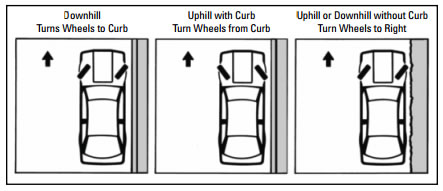Illinois Rules of the Road: Parking
This article details and explains laws, rules and regulations related to parking vehicles in Illinois.
Hill Parking
Any time drivers park on a hill, they should put the gear select in park and set the parking/emergency brake if necessary. When starting a vehicle from an uphill or downhill location, a driver should release the parking/emergency brake, give the correct signal, check for oncoming traffic and proceed when it is safe to do so.
- If drivers park on a street with curbing and the vehicle is facing downhill, they should turn the front wheels toward the curb so the vehicle will roll toward the curb.
- If drivers park facing uphill and there is a curb, they should turn the front wheels away from the curb.
- If drivers park on a street without curbing, they should turn the wheels toward the side of the road on which the vehicle is parked.
Parallel Parking
When parking on streets with two-way traffic, a driver should park so the right-hand wheels are parallel to and within 12 inches of the curb. On a one-way street or road, the vehicle should be parked within 12 inches of the right or left curb. Vehicles must be parked in the direction in which traffic is moving.
Parking for Persons with Disabilities
Vehicles displaying license plates or parking placards for persons with disabilities may use spaces reserved for persons with disabilities. The authorized holder of the parking placard or license plates must be present and must enter or exit the vehicle at the time the parking privileges are being used.
A striped area on the pavement next to the disabled parking space is part of the reserved space and vehicles may not use this striped area for parking even if they have a disabled parking placard or disability license plates.
Parking for Electric Vehicles
Some parking areas may have spaces equipped with charging stations for electric vehicles. Only electric vehicles are allowed to park in these designated spaces.
Prohibited Stopping, Standing and Parking
Stopping, standing or parking is prohibited in specified places in Illinois. Local stopping, standing and parking regulations may be posted on signs.
There are, however, statewide regulations that are not always indicated by signs.
Stopping, standing or parking is prohibited:
- On the roadway side of any parked vehicle (double parking).
- On a sidewalk, crosswalk or within an intersection.
- Between a safety zone and the adjacent curb.
- Beside or opposite any street excavation or obstruction if the vehicle would block traffic.
- On any bridge, overpass, railroad track or within a highway tunnel.
- On any controlled access roadway — one where a vehicle may enter or exit only at certain points.
- In the area between roadways of a divided highway, including crossovers.
- On a paved roadway or highway outside business or residential districts when it is practical to stop or park off the roadway. In an emergency, drivers may stop their vehicle and park only if there is a clear view for 200 feet in each direction. The driver should turn on the emergency flashers and make sure there is enough space for other vehicles to pass.
- At any place where official signs prohibit stopping, standing or parking.
Standing or parking a vehicle, whether occupied or not, is prohibited:
- In front of a public or private driveway.
- Within 15 feet of a fire hydrant.
- Within 20 feet of a fire station driveway or crosswalk at an intersection.
- Within 30 feet of a STOP sign, YIELD sign or traffic control signal.
Parking a vehicle, whether occupied or not, is prohibited:
- Within 50 feet of the nearest rail of a railroad crossing.
- On a highway between sunset and sunrise unless the front and rear parking lights are displayed or the vehicle is within an urban district where lights are not required. Headlights on parked vehicles must be dimmed.

